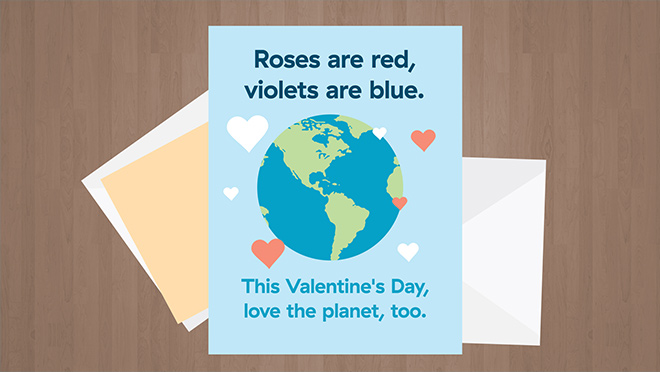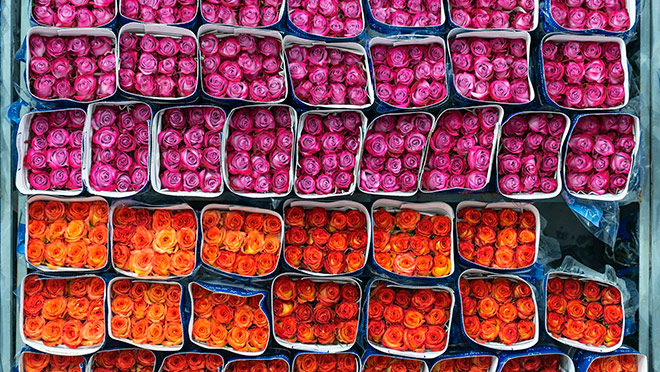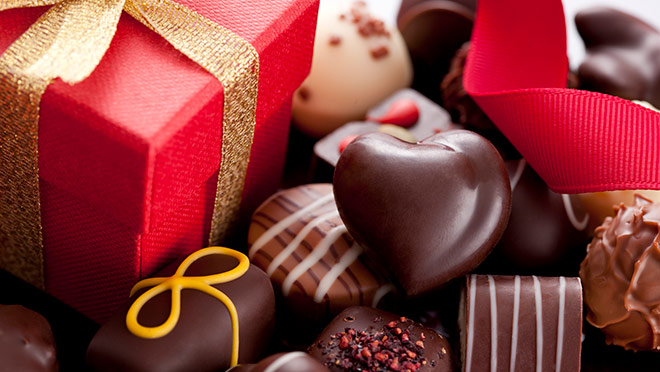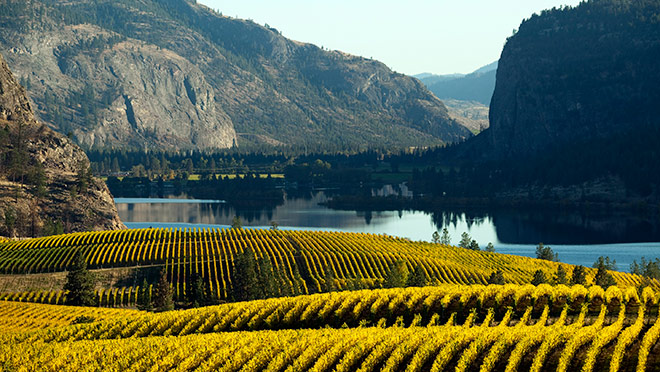Eat, drink, and love the planet this Valentine's Day

Consider fair trade flowers and chocolate, and what you eat, this February 14
Roses are red, violets are blue... this Valentine's Day, love the planet, too.
While we don't have numbers around what Valentine's Day produces in Canada, there are some staggering estimates out of the U.S.: 148 million greeting cards, 198 million roses, and 58 million pounds of chocolate.
The collective footprint of all this love is enormous, because that's a whole lot of trees, and a massive amount of pesticides and carbon emissions associated with the production and transport of chocolate, roses, wine, and all those romantic meals consumed. But there are easy ways to ensure you're not contributing to that footprint or to the unfair treatment of workers in foreign countries.
Here are ways to embrace Valentine's Day in a more responsible way:

Choose local or fair trade flowers
From the way workers are treated, to pesticides used, the water required, and the CO2 footprint of transport – usually by refrigerated truck and airplane – there's a massive ecological footprint attached to most flowers you buy in Canada. In 2018, it was estimated that Valentine's Day flowers grown in Colombia and flown to U.S. airports produced 360,000 metric tons of CO2 – or the equivalent of 78,000 cars driven for a year.
Take the time to buy fair trade flowers, a designation for growers who adhere to higher standards around working conditions and worker rights. And better yet, buy Canadian-grown flowers if you can track them down. Eurosa Farms on Vancouver Island is Canada's only commercial rose grower, and many florists around B.C. make it a priority to source local and fair trade flowers as much as possible.
Check online, talk to your local florist, or check Eurosa Farms' vendor list, for local and fair trade options near you.

Check where that chocolate comes from
Taste and cocoa content aren't the only differences from one chocolate confection to another. The majority of chocolate consumed in North America comes from West Africa, and notably from Ivory Coast, which produces about a third of the world's cocoa.
In 2019, the Yale School of the Environment estimated that in Ivory Coast – where more than 80% of the forest is gone – about 40% of the country's cocoa crop was grown illegally in national parks and in supposedly protected government-owned forests. According to the Yale school, most cocoa is grown in monocultures of what is known as the full-sun system, requiring the removal of all surrounding trees.
You've probably seen fair trade labelling on chocolate bars. Look for the fair trade label at your local store, and note that pressure from fair trade advocates has led to chocolatiers such as Purdy's (funding to help workers) and Rogers (committed to using 100% fair trade cocoa) embarking on their own sustainability and fair trade programs.
Make your own Valentine's Day card
Some of you might remember making Valentine's Day greetings in school or at home as a young child. Or perhaps you can recall the effect a handmade card had on a friend or loved one. Nothing says love like a personalized, handmade card.
Use scrap paper if you have some in your home, or get creative with leftover bits from holiday gift wrapping. Take a shot at poetry, or borrow a quote you love. Maybe even skip the card in favour of reciting poetry, or scattering fair trade chocolates on the table in time for your partner's arrival.
Opt for a vegetarian or more sustainable meal
The eco footprint of meat – in particular beef and lamb – is now a rallying cry for a shift toward more veggies and fruits in our diets. And chefs are very much in tune with this quiet revolution, putting a gourmet spin on everything from brussels sprouts to the humble pea.
Check online for outstanding local vegetarian and other restaurants known for vegetarian or sustainability-minded dishes. And take a look at some of these non-meat dishes from Vancouver restaurants recently selected for Michelin Guide status:
- Stracciatella, with butternut squash, pumpkin seed and sage crumble, white balsamic vin (Barbara)
- Savoury profiteroles, goat camembert mousse, grilled radicchio (Burdock & Co.)
- Charcoal udon (dungeness crab, prawns, squid, Calabrian chili butter) (Kissa Tanto)
- Roasted Manitoba pickerel, with celery and green dashi (Published on Main)
- Maple cured Sablefish, split-pea soup, leek and ham (St. Lawrence)

Choose a B.C. wine
Gone are the days when we needed to look to Old World wines, or New World wines from the likes of Australia, for excellence. Red, white, and sparkling, B.C. wines are making noise near and far, and the CO2 emissions related to their transport make them a more eco-friendly choice.
A U.K.-based analysis of CO2 emissions related to the transport of a bottle of wine in 2020 found that while a bottle imported from France carried a CO emissions cost of 91 grams, compared to 295 g for an Australian bottle and 262 g from a bottle imported from Argentina. Several B.C. winemakers are also looking for more sustainable ways of producing their wine, as well.
Not sure which B.C. wines to buy? Talk to the experts at your local liquor store or wine shop, check out online reviews, or visit winebc.com and download the Wines of BC Explorer app to your smartphone.
Turn down the heat, turn up the cuddle
Turn up the romance and turn down the heat on Valentine's Day. Grab a sweater or a blanket as you cuddle on the couch and turn down the heat as you head to bed. Did you know that heating costs can increase by about 5% for every degree above 20°C (68°F)?
Here's what we recommend in terms of setting your thermostats at home:
- Going to sleep? Set your thermostat to 16°C as you turn in for the night.
- Doing housework or cooking? Set your thermostat to 18°C to keep you comfortable.
- Reading or watching TV: Set your thermostat to 21°C for energy-efficient relaxation.